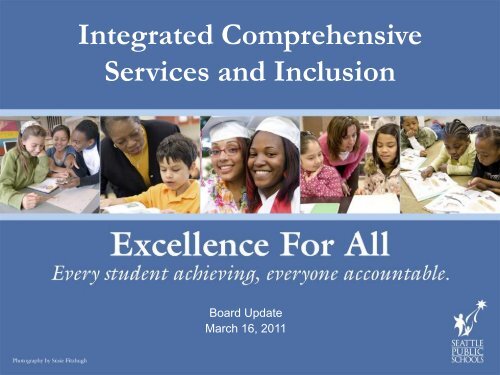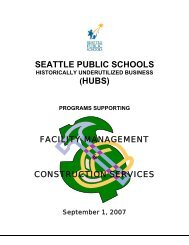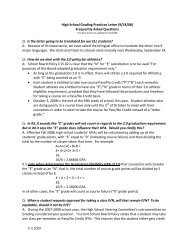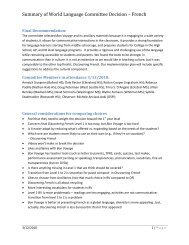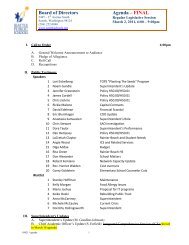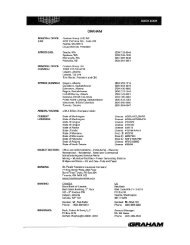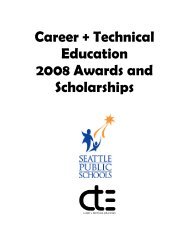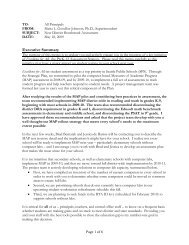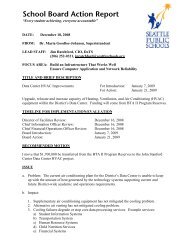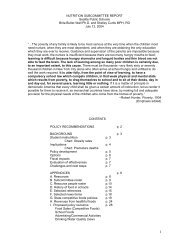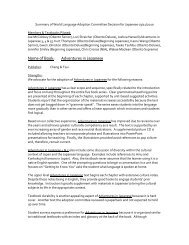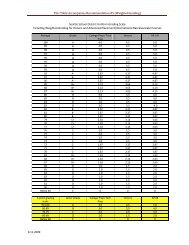ICS Presentation - Seattle Public Schools
ICS Presentation - Seattle Public Schools
ICS Presentation - Seattle Public Schools
Create successful ePaper yourself
Turn your PDF publications into a flip-book with our unique Google optimized e-Paper software.
Integrated Comprehensive<br />
Services and Inclusion<br />
Board Update<br />
March 16, 2011
Key Audit Recommendation<br />
Students with disabilities will :<br />
• First be provided instruction in the general education<br />
classroom,<br />
• Receive standards-based curriculum in a manner that they<br />
learn the most and can show what they know<br />
Both general and special education teachers will:<br />
• Be provided the appropriate training … in support of the<br />
range of learners<br />
2
Key Data Point: Disproportionality<br />
(OSPI 2010)<br />
Students of color--African American, Hispanic,<br />
American Indian/Alaskan Native--are<br />
disproportionally represented in “segregated”<br />
or self-contained programs.<br />
• They are 2 to 3 times as likely to be identified as<br />
Emotionally/Behaviorally Disabled<br />
• They are 2 to 3 times as likely to be identified as Intellectually<br />
Disabled<br />
• They are half as likely (.5 weighted risk ratio) to be identified<br />
as having Autism<br />
3
Placement and Services<br />
Students with disabilities will :<br />
‣ First be provided instruction in the general education<br />
classroom.<br />
Barriers:<br />
• Historically, students with moderate to intense needs have to<br />
attend “programs” in specific schools, often away from<br />
neighborhood peers and/or siblings, and often with limited<br />
access to general education<br />
• “Inclusion” for students with moderate to intense needs<br />
consistently available only to students with specific disabilities<br />
4
Placement and Services<br />
Integrated Comprehensive Services<br />
Last Year<br />
This Year<br />
• 68 students with moderate<br />
needs learning inclusively (K-<br />
1)<br />
• In 32 home schools<br />
• Supported by 45 additional<br />
staff (ARRA funded)<br />
• 150 students with moderate<br />
needs learning inclusively (K-<br />
2)<br />
• In 40 home schools<br />
• Supported by 45 additional<br />
staff (ARRA funded)<br />
5
Curriculum<br />
Students with disabilities will :<br />
‣ Receive standards-based curriculum in a manner that<br />
they learn the most and can show what they know<br />
Barriers:<br />
• Historically Special Education teachers have not been trained<br />
in core content<br />
• IEP learning goals have been unrelated to standards<br />
• Instruction not differentiated to allow for true inclusion of<br />
students with different learning needs<br />
6
Professional Development<br />
Both general and special education teachers<br />
will:<br />
‣ Be provided the appropriate training … in support of<br />
the range of learners<br />
Barriers:<br />
• Specialized programs prevent teachers from developing a<br />
range of skills and expertise<br />
• Limited knowledge of strategies to support students with<br />
mild to moderate social and emotional needs<br />
7
Professional Development<br />
Integrated Comprehensive Services<br />
• Inclusion and Co-Teaching Institutes: Summer 2009,<br />
November 2009, Summer 2010<br />
• Inclusion Workshops and On-Site Training provided by<br />
Special Education staff<br />
• Training provided by partners at the University of<br />
Washington (Prof. Ilene Schwartz and Chris Matsumoto): 12<br />
Elementary <strong>Schools</strong> during Winter 2011<br />
• Training and coaching with Dr. Cassie Martin: Inclusion 101<br />
and 102, with follow-up coaching<br />
• Inclusion Coaches work with high needs schools to develop<br />
team structures and common strategies<br />
8
Sandall and Schwartz, “Building<br />
Blocks”<br />
Specially Designed<br />
Instruction (SDI)<br />
(Child Focused)<br />
% of time SDI in Sp. Ed. class<br />
% of time<br />
SDI<br />
Specially Designed Instruction (SDI)<br />
(Embedded Instruction)<br />
% of time SDI in Gen.<br />
Ed.<br />
General Education<br />
(Accommodations and Modification)<br />
% of time<br />
Gen. Ed.<br />
with support<br />
% of time in<br />
Gen. Ed.<br />
General Education<br />
(High Quality Program)<br />
% of time<br />
Gen. Ed.<br />
Independent<br />
9
120<br />
Students With Disabilities: Elementary Short-Term<br />
Suspensions<br />
09-10 to 10-11<br />
100<br />
80<br />
60<br />
40<br />
20<br />
0<br />
September to November 2009 September to November 2010<br />
10
Issues and Concerns<br />
Integrated Comprehensive Services<br />
• Expertise in supporting specific disability needs, such as Autism,<br />
is not consistent; families fear that their student’s needs will not<br />
be met.<br />
• Training takes time and school staff feel stretched by multiple<br />
demands.<br />
• New challenges for General Education teachers; teachers do not<br />
feel supported by special education building and/or central staff.<br />
• General Education and Special Education staff do not have time<br />
to collaborate.<br />
11
Next Steps For Sustainable Inclusion<br />
• Enhanced WSS “Resource” staffing ratio—more attendance area<br />
schools can effectively serve a broader range of students<br />
• Elementary paid planning time for collaboration<br />
• Elimination of “contact time reduction” in the WSS model:<br />
EVERY student has a place in a general education homeroom as<br />
well as Special Education supports<br />
• Deepening professional partnership with the University of<br />
Washington (e.g., video library of best practices)<br />
• Special Education must be the shared work of all staff<br />
• Services rather than programs<br />
12


